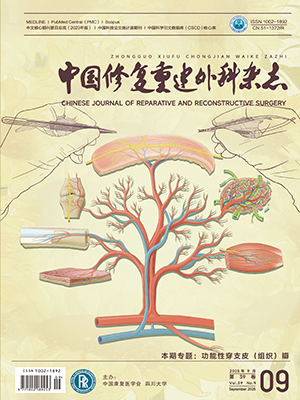| 1. |
Alvarez L, Pérez-Higueras A, Granizo JJ, et al. Predictors of outcomes of percutaneous vertebroplasty for osteoporotic vertebral fractures. Spine (Phila Pa 1976), 2005, 30(1): 87-92.
|
| 2. |
祝腾蛟, 田耘, 周方. 骨质疏松性椎体压缩骨折微创治疗的现状和进展. 中国微创外科杂志, 2015, 15(12): 1121-1124.
|
| 3. |
Wasfie T, Jackson A, Brock C, et al. Does a fracture liaison service program minimize recurrent fragility fractures in the elderly with osteoporotic vertebral compression fractures? Am J Surg, 2019, 217(3): 557-560.
|
| 4. |
马航展, 马金火, 褚学远, 等. 单侧入路椎体成形术治疗骨质疏松性胸腰椎骨折. 中国矫形外科杂志, 2019, 27(12): 1068-1072.
|
| 5. |
刘爱华, 吴中学, 杨新健, 等. 单侧入路的椎体成形术治疗老年椎体压缩性骨折. 中国现代医学杂志, 2006, 16(17): 2623-2625, 2628.
|
| 6. |
金成浩, 蔡迎, 钟杰林, 等. 单侧与双侧经皮后凸成形治疗骨质疏松性胸腰椎骨折. 中国矫形外科杂志, 2020, 28(18): 1712-1715.
|
| 7. |
何仕诚, 滕皋军, 邓钢, 等. 椎体成形术治疗合并囊腔样变的骨质疏松性椎体压缩骨折. 介入放射学杂志, 2005, 14(3): 256-260.
|
| 8. |
李哲, 苏庆军, 海涌. 伴有椎体内裂隙征的骨质疏松性椎体压缩骨折的诊治进展. 中国脊柱脊髓杂志, 2017, 27(7): 647-651.
|
| 9. |
夏维财. 经皮椎体后凸成形术治疗老年骨质疏松性椎体压缩骨折. 中国微创外科杂志, 2015, 15(3): 280-281, 288.
|
| 10. |
El-Fiki M. Vertebroplasty, kyphoplasty, lordoplasty, expandable devices, and current treatment of painful osteoporotic vertebral fractures. World Neurosurg, 2016, 91(1): 628-632.
|
| 11. |
沈凯, 张胜利, 谭祖键, 等. 经皮椎体后凸成形术治疗骨质疏松性椎体压缩骨折中骨水泥单侧与双侧弥散对疗效的影响. 中华创伤杂志, 2018, 34(6): 527-533.
|
| 12. |
Ma X, Xing D, Ma J, et al. Risk factors for new vertebral compression fractures after percutaneous vertebroplasty: qualitative evidence synthesized from a systematic review. Spine (Phila Pa 1976), 2013, 38(12): E713-E722.
|
| 13. |
Linville DA. Vertebroplasty and kyphoplasty. South Med J, 2002, 95(6): 583-587.
|
| 14. |
Zapałowicz K, Radek M. Percutaneous balloon kyphoplasty in the treatment of painful vertebral compression fractures: effect on local kyphosis and one-year outcomes in pain and disability. Neurol Neurochir Pol, 2015, 49(1): 11-15.
|
| 15. |
Lieberman IH, Dudeney S, Reinhardt MK, et al. Initial outcome and efficacy of “kyphoplasty” in the treatment of painful osteoporotic vertebral compression fractures. Spine (Phila Pa 1976), 2001, 26(14): 1631-1638.
|
| 16. |
Khairallah A. Descemet stripping automated endothelialkeratoplasty (DSAEK) versus repeat penetrating keratoplasty (PKP) to manage eyes with failed corneal graft. Ann Saudi Med, 2018, 38(1): 36-41.
|
| 17. |
赵继荣, 邓强, 王兴盛, 等. 老年骨质疏松性压缩骨折经皮穿刺椎体成形术后疗效不佳相关因素. 中国老年学杂志, 2018, 38(19): 4678-4680.
|
| 18. |
Zhang L, Liu Z, Wang J, et al. Unipedicular versus bipedicular percutaneous vertebroplasty for osteoporotic vertebral compression fractures: a prospective randomized study. BMC Musculoskelet Disord, 2015, 16: 145. doi: 10.1186/s12891-015-0590-6.
|
| 19. |
Hu KZ, Chen SC, Xu L. Comparison of percutaneous balloon dilation kyphoplasty and percutaneous vertebroplasty in treatment for thoracolumbar vertebral compression fractures. Eur Rev Med Pharmacol Sci, 2018, 22(1 Suppl): 96-102.
|
| 20. |
陈亮, 杨惠林, 唐天驷. 后凸成形术治疗多椎体骨质疏松性压缩骨折的疗效分析. 中华骨科杂志, 2009, 29(4): 310-314.
|
| 21. |
格日勒, 刘鑫, 杨鹏, 等. 经皮椎体成形和经皮椎体后凸成形治疗老年骨质疏松性椎体压缩性骨折的对比. 中国微创外科杂志, 2019, 19(12): 1084-1087.
|




